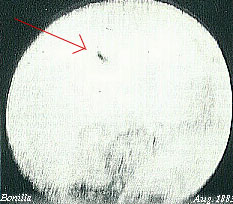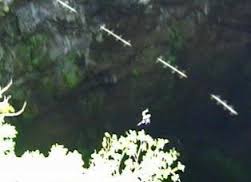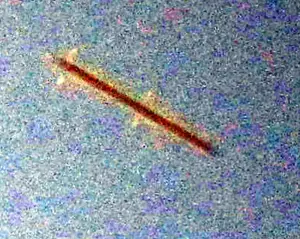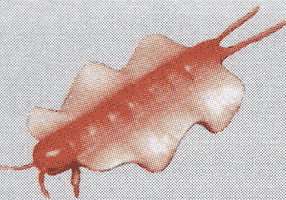Podcast: Play in new window | Download
Subscribe: Apple Podcasts | RSS
 In May of 2016, Alberto Ignacio Alejo Ibarra whipped out his phone and with his camera feature recorded a strange anomaly in the skies of his hometown of Guadalajara, Mexico. The video shows a translucent object with a tail appearing to “swim” over the skies of Jalisco. It lazily moves through the air and looks somewhat like a manta ray or a fish with a long tail. The video lasts for a few minutes and has been analyzed by many. For some, the anomaly looks like a blue plastic grocery store bag carried aloft by wind currents. Others have claimed that it is the remains of a weather balloon coming down to earth or that the object is simply a blue, heart-shaped balloon with a thick ribbon attached to it. With advanced computer technology in the hands of everyone these days, was this video simply a clever fake? Away from the earthly and computer-generated explanations of this video we have a whole group of people, investigators in the paranormal and cryptozoologists, who think that Alberto’s video shows a previously unclassified group of creatures called “skyfish,” to include what has been termed “rods,” or in Spanish, los rods, supposed quick-flying, nearly invisible creatures that live in the far reaches of the stratosphere.
In May of 2016, Alberto Ignacio Alejo Ibarra whipped out his phone and with his camera feature recorded a strange anomaly in the skies of his hometown of Guadalajara, Mexico. The video shows a translucent object with a tail appearing to “swim” over the skies of Jalisco. It lazily moves through the air and looks somewhat like a manta ray or a fish with a long tail. The video lasts for a few minutes and has been analyzed by many. For some, the anomaly looks like a blue plastic grocery store bag carried aloft by wind currents. Others have claimed that it is the remains of a weather balloon coming down to earth or that the object is simply a blue, heart-shaped balloon with a thick ribbon attached to it. With advanced computer technology in the hands of everyone these days, was this video simply a clever fake? Away from the earthly and computer-generated explanations of this video we have a whole group of people, investigators in the paranormal and cryptozoologists, who think that Alberto’s video shows a previously unclassified group of creatures called “skyfish,” to include what has been termed “rods,” or in Spanish, los rods, supposed quick-flying, nearly invisible creatures that live in the far reaches of the stratosphere.
 Perhaps the first person ever to see skyfish was a man named José Bonilla, an astronomer working at the observatory at Cerro de la Bufa which overlooks the city of Zacatecas. The date was August 12, 1883, and Bonilla was taking pictures of sunspots when he observed nearly 300 unidentified flying objects crossing the sun. The photos were taken on wet plates with an exposure of one one-hundredth of a second. This 1883 sighting is considered to be the first UFO sighting in modern Mexican history. José Bonilla noted the irregular movements of the objects he saw and when he made his photographs public the objects were dismissed as high-flying geese. A 2011 investigation of Bonilla’s plates by UNAM, the National Autonomous University of Mexico, stated that the objects were possibly the fragments of a billion-ton comet that was passing by earth at the time. Other investigators with a more paranormal bent claim that the 1883 José Bonilla photographs not only represent the first tangible records of UFOs in Mexico, but they depict the elusive skyfish.
Perhaps the first person ever to see skyfish was a man named José Bonilla, an astronomer working at the observatory at Cerro de la Bufa which overlooks the city of Zacatecas. The date was August 12, 1883, and Bonilla was taking pictures of sunspots when he observed nearly 300 unidentified flying objects crossing the sun. The photos were taken on wet plates with an exposure of one one-hundredth of a second. This 1883 sighting is considered to be the first UFO sighting in modern Mexican history. José Bonilla noted the irregular movements of the objects he saw and when he made his photographs public the objects were dismissed as high-flying geese. A 2011 investigation of Bonilla’s plates by UNAM, the National Autonomous University of Mexico, stated that the objects were possibly the fragments of a billion-ton comet that was passing by earth at the time. Other investigators with a more paranormal bent claim that the 1883 José Bonilla photographs not only represent the first tangible records of UFOs in Mexico, but they depict the elusive skyfish.
 A century after Bonilla’s photographs, sophisticated camera equipment became more affordable for average people. By the middle of the 1990s, with more anomalies in the skies recorded on film, we see the beginnings of the classification of skyfish as a possible cryptid or previously unknown animal. According to paranormal investigator Fon Ramos creator of the website Atraviesa lo desconocido – “Across the Unknown” in English – and author of the book, Nuestro origen extraterrestre y otros misterios del cosmos – Our Extraterrestrial Origins and Other Mysteries of the Cosmos – skyfish were first recorded in our era in the mid-1990s when an American cameraman named Mark Lichtle was filming parachutists jumping into a deep cave just outside of San Luís Potosí, the capital city of the Mexican state of the same name. The mysterious flying objects, classified as the rod-like skyfish, were only noticed later when the film was being reviewed by Lichtle in slow motion. Various skyfish darted around the base jumpers, some even going around the jumpers to avoid collision. The creatures appear to be somewhat
A century after Bonilla’s photographs, sophisticated camera equipment became more affordable for average people. By the middle of the 1990s, with more anomalies in the skies recorded on film, we see the beginnings of the classification of skyfish as a possible cryptid or previously unknown animal. According to paranormal investigator Fon Ramos creator of the website Atraviesa lo desconocido – “Across the Unknown” in English – and author of the book, Nuestro origen extraterrestre y otros misterios del cosmos – Our Extraterrestrial Origins and Other Mysteries of the Cosmos – skyfish were first recorded in our era in the mid-1990s when an American cameraman named Mark Lichtle was filming parachutists jumping into a deep cave just outside of San Luís Potosí, the capital city of the Mexican state of the same name. The mysterious flying objects, classified as the rod-like skyfish, were only noticed later when the film was being reviewed by Lichtle in slow motion. Various skyfish darted around the base jumpers, some even going around the jumpers to avoid collision. The creatures appear to be somewhat  translucent, about one to two meters long, and thus ruled out the possibility of birds or insects. The American photographer had a mystery on his hands and didn’t know what to do with the footage.
translucent, about one to two meters long, and thus ruled out the possibility of birds or insects. The American photographer had a mystery on his hands and didn’t know what to do with the footage.
Slightly earlier than the San Luís Potosí photographic anomalies, we have similar objects being filmed outside the town of Real de Palmas in the Mexican state of Nuevo León. On March 19, 1994 a man named Santiago Ytturia set up his video camera in anticipation of recording the UFOs that neighbors had spoken of seeing the past few evenings. Nearly discouraged after hours of waiting, Santiago was about to give up when he saw strange flashing lights in the sky. He filmed the darting lights and thought that was all he captured with his video camera. Later Santiago reviewed the film in slow motion and after the UFO had disappeared from view he noticed something highly unusual: spear-like images with strange small appendages, only seen when he reviewed the film frame by frame. They flew by so fast that they were nearly invisible to the naked eye. Had he discovered some strange atmospheric disturbance previously not described or was this some special type of UFO?
 In the same month in 1994, a few hundred miles away from Santiago’s home in Nuevo León, a man named José Escamilla was also setting up his camera in hopes of filming UFOs. He had had a UFO sighting in the 1960s when he was with other members of his local rock and roll band. He had seen strange lights outside his home in March of 1994 and wanted to record them. Escamilla recorded 16 minutes of footage and like the previous people he only saw the anomalous rod-like flying things when he slowed down the footage. At first he thought they were insects flying too close to the camera, but dismissed this because the objects were far and not close. José’s curiosity was unrelenting and that began for him a lifetime of trying to figure out what these images were. He is considered to be the most expert researcher in this topic and has appeared on various TV and radio shows and participates actively in the UFO and paranormal lecture circuit. Through his internet presence and fame within the UFO and paranormal communities, José has amassed quite a bit of information on the skyfish, including much video evidence submitted from all parts of the world showing these strangely moving objects in the sky.
In the same month in 1994, a few hundred miles away from Santiago’s home in Nuevo León, a man named José Escamilla was also setting up his camera in hopes of filming UFOs. He had had a UFO sighting in the 1960s when he was with other members of his local rock and roll band. He had seen strange lights outside his home in March of 1994 and wanted to record them. Escamilla recorded 16 minutes of footage and like the previous people he only saw the anomalous rod-like flying things when he slowed down the footage. At first he thought they were insects flying too close to the camera, but dismissed this because the objects were far and not close. José’s curiosity was unrelenting and that began for him a lifetime of trying to figure out what these images were. He is considered to be the most expert researcher in this topic and has appeared on various TV and radio shows and participates actively in the UFO and paranormal lecture circuit. Through his internet presence and fame within the UFO and paranormal communities, José has amassed quite a bit of information on the skyfish, including much video evidence submitted from all parts of the world showing these strangely moving objects in the sky.
 These anomalies have several things in common, according to José, and he has his theories as to what they could be. They move very fast – hundreds of miles per hour -and are almost never visible to the naked eye. They seem to be very common in Mexico, the southwest US, and parts of South America. There have also been reports of them in parts of Europe and China. They are cylindrical in shape and measure from about 4 inches to up to 9 feet in length. The have many appendages on their sides which run the full length of their bodies and may be attached to light wings. Please go to our web site, Mexico Unexplained dot com to see pictures of skyfish. They appear to fly through the air by using an undulating solid membrane which vibrates very rapidly on each side of their bodies very similar to how squids propel themselves through water. Skyfish are usually translucent. Skyfish have been observed flying in and out of large bodies of water. Escamilla theorizes that these are living organisms, animals that have adapted to predators over the years by developing translucence and by flying fast. Although not resembling any known animal currently living on earth, they are not extraterrestrials but a creature that has lived on earth for many years. Why has a body of a
These anomalies have several things in common, according to José, and he has his theories as to what they could be. They move very fast – hundreds of miles per hour -and are almost never visible to the naked eye. They seem to be very common in Mexico, the southwest US, and parts of South America. There have also been reports of them in parts of Europe and China. They are cylindrical in shape and measure from about 4 inches to up to 9 feet in length. The have many appendages on their sides which run the full length of their bodies and may be attached to light wings. Please go to our web site, Mexico Unexplained dot com to see pictures of skyfish. They appear to fly through the air by using an undulating solid membrane which vibrates very rapidly on each side of their bodies very similar to how squids propel themselves through water. Skyfish are usually translucent. Skyfish have been observed flying in and out of large bodies of water. Escamilla theorizes that these are living organisms, animals that have adapted to predators over the years by developing translucence and by flying fast. Although not resembling any known animal currently living on earth, they are not extraterrestrials but a creature that has lived on earth for many years. Why has a body of a  skyfish never been found? Like an octopus, it is theorized, the skyfish may be comprised mostly of soft tissue and may decompose quickly. Skyfish sightings are increasing and that may be just because camera technology has become more sophisticated and more widespread than ever. Also, there are just more people living in concentrated areas than ever before in human history. Take, for example, the mass sightings of rod-like skyfish sighted over Mexico City in May of 2015 seen by untold thousands. With a population of almost 25 million people – that’s 50 million eyes – there is a greater chance for mass sightings of any sort of UFOs in the skies. José Escamilla claims that governments of the world are aware of this flying creature and he has alleged that his phone has been tapped and that his skyfish activities are being monitored. He remains determined to continue with his research and remains a clearinghouse of information for all things skyfish to this day.
skyfish never been found? Like an octopus, it is theorized, the skyfish may be comprised mostly of soft tissue and may decompose quickly. Skyfish sightings are increasing and that may be just because camera technology has become more sophisticated and more widespread than ever. Also, there are just more people living in concentrated areas than ever before in human history. Take, for example, the mass sightings of rod-like skyfish sighted over Mexico City in May of 2015 seen by untold thousands. With a population of almost 25 million people – that’s 50 million eyes – there is a greater chance for mass sightings of any sort of UFOs in the skies. José Escamilla claims that governments of the world are aware of this flying creature and he has alleged that his phone has been tapped and that his skyfish activities are being monitored. He remains determined to continue with his research and remains a clearinghouse of information for all things skyfish to this day.
 As with everything decidedly “fringe,” the skyfish phenomenon is not without its critics. When trying to debunk the skyfish the critics usually begin with camera errors and camera lens effects. Many of these supposed skyfish photos and videos can be explained away by tricks and aberrations of light. In other words, these images are simply just byproducts of photography. In general, when an image moves too fast in front of a still camera, the image blurs. When you take a picture of a person running, for example, there might be a slight blur in the arms and legs of the subject. It doesn’t mean the person is morphing into something else, it is just a camera effect. The use of outdated or poorly maintained cameras in Mexico as an explanation for these anomalies is dismissed by counter-critics as racism. The seemingly easy explanations for photographs do not explain images seen in video and digital camera footage, but most critics have chalked up these motion picture examples to insects or the wind blowing small objects like airborne seeds through the air. Much like with Bigfoot, a body has yet to be produced of a skyfish for scientific examination. There has also been no biological precedent for this supposed cryptid. If they exist, what did they evolve from? In spite of the critiques, José Escamilla still pursues his studies, thus continuing the research of another José, his 19th Century counterpart from Zacatecas. Perhaps with better technology and more people investigating this phenomenon worldwide, José might finally have answers to this curious mystery.
As with everything decidedly “fringe,” the skyfish phenomenon is not without its critics. When trying to debunk the skyfish the critics usually begin with camera errors and camera lens effects. Many of these supposed skyfish photos and videos can be explained away by tricks and aberrations of light. In other words, these images are simply just byproducts of photography. In general, when an image moves too fast in front of a still camera, the image blurs. When you take a picture of a person running, for example, there might be a slight blur in the arms and legs of the subject. It doesn’t mean the person is morphing into something else, it is just a camera effect. The use of outdated or poorly maintained cameras in Mexico as an explanation for these anomalies is dismissed by counter-critics as racism. The seemingly easy explanations for photographs do not explain images seen in video and digital camera footage, but most critics have chalked up these motion picture examples to insects or the wind blowing small objects like airborne seeds through the air. Much like with Bigfoot, a body has yet to be produced of a skyfish for scientific examination. There has also been no biological precedent for this supposed cryptid. If they exist, what did they evolve from? In spite of the critiques, José Escamilla still pursues his studies, thus continuing the research of another José, his 19th Century counterpart from Zacatecas. Perhaps with better technology and more people investigating this phenomenon worldwide, José might finally have answers to this curious mystery.
REFERENCES (This is not a formal bibliography)
“Primeras fotos de ‘OVNIS’ fueron captadas en Zacatecas en 1883” article in the October 8, 2015 edition of Excelsior (in Spanish)
Inexplicata – The Journal of Hispanic UFOlogy (online)
Atraviesa lo desconocido (online, in Spanish)
Various online sources

7 thoughts on “José and the Skyfish”
I have sightings nightly if anyone is interested in researching them further.
Hey! I am! 🙂
I have quite a few videos of these creatures as well. I’d be happy to email them if needed.
I’d love to see them.
I’m going to the Sótano tomorrow evening. How should I catch them on camera? Any pointers?
Sincerely,
Ben
Where would you like me to send them?
You can send them to my personal email: bitto@juno.com. Thanks!